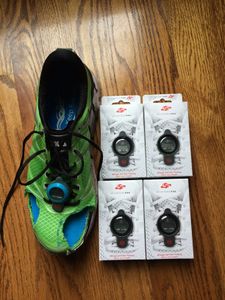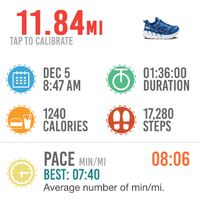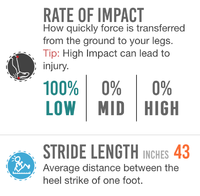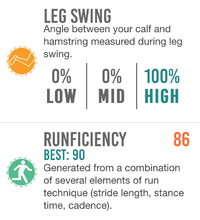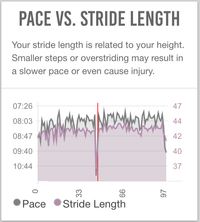Difference between revisions of "MilestonePod"
From Fellrnr.com, Running tips
User:Fellrnr (User talk:Fellrnr | contribs) (Created page with "I liked the MilestonePod so much I brought five of them. The MilestonePod is a simple way of tracking the mileage of your shoes, b...") |
(No difference)
|
Revision as of 18:16, 5 December 2015
The MilestonePod is a simple way of tracking the mileage of your shoes, but it will also gather data on your Running Form. I think the MilestonePod is well worth the price even if it only tracked overall mileage for your shoes. Given the extra data it records, it's a real bargain. Error: Could not parse data from Amazon!
- The MilestonePod has a small LCD display that shows the total miles recorded for that shoe.
- For each run it will record your distance, time, and number of steps. Like all Footpods, the MilestonePod requires calibration on each run.
- The MilestonePod records the percentage of time spent in Heel, Mid, and Forefoot Foot Strikes.
- Cadence is recorded as an average and best (maximum value) for each run. From the distance and the Cadence, stride length is calculated.
- Stance Time, which is more commonly called Ground Contact Time is how long your foot is on the ground rather than in the air. Again, the average and best (minimum) time is recorded for each run. The The Science of Running Economy indicates that longer Ground Contact Time costs more energy (reduced Running Economy.)
- The impact force of your foot landing is recorded as a percentage of time that is low, medium, or high. The Science of Running Shoes does not support the idea that higher impact results in higher injury rates, and there's some evidence to the contrary.
- Leg swing is the angle between your upper and lower leg after toe off. A narrower angle, which is where the foot is closer to your hip with a more bent knee can reduce the effort needed to bring the trailing leg forward for the next stride.
- MilestonePod calculates a "runficiency" score, which is intended to reflect your overall efficiency.
- There are a few graphs that are available but these are rather small and tricky to interpret. They show "pace vs. cadence", "pace vs. stride length", "pace vs. stance time", "pace vs. runficiency", plus a graph of Foot Strike, Rate of Impact, and Leg Angle.
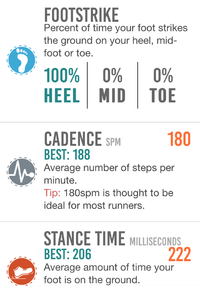 Foot Strike, Cadence and Stance Time (Ground Contact Time) |
1 Limitations
There are a number of limitations to the MilestonePod.
- There is no real time data available during your run, and you have to sync with a Smartphone when you're finished to see the data.
- The data is only available on your Smartphone, not their web site.
- The MilestonePod does not act as a Footpod for a Bluetooth watch like the Polar V800.
- There is no data export or detailed analytics of the data.
Some of these limitations could be resolved in future firmware updates, but I don't have any insight into this.
2 Compared with RunScribe
RunScribe is a much more expensive and more sophisticated device that has quite different capabilities. I highly recommend both devices, as they fulfill different purposes.
- The MilestonePod is an easy way to track the mileage of your shoes. This is something that is as easy with RunScribe, especially given that devices more limited battery life.
- MilestonePod does not provide the detailed metrics that is available from RunScribe. There is some overlap, such as Ground Contact Time, but MilestonePod only give summary data, not a detailed graph over time.
- While you could wear two MilestonePod, one on each foot, they are not designed to give comparison data to find biomechanical imbalances.
